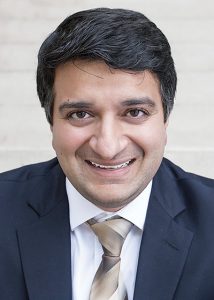By Sandip Pravin Patel, MD, and Martin Edelman, MD
Posted: August 19, 2020


COVID-19 has drastically affected medicine and broader society. With physical distancing necessitating the need to overcome limitations in prevention and treatment, telehealth has become a preferred solution to minimize patient exposure during COVID-19. Th is is particularly relevant for patients with cancer who are at higher risk of potentially fatal complications from COVID- 19. Telehealth in its current form uses secured videoconferencing for a televisit between a patient and provider.
The necessary components on the patient side for a virtual visit include a smartphone, broadband internet, and technological proficiency in operating a smartphone application. However, while telehealth has served an important short-term role in facilitating physical distancing within health systems and providing time to adapt to the demands regarding testing, provision and use of protective gear, and similar issues, many view telehealth as a longterm replacement for in-person visits. Our own experience has been that telehealth is a nice short-term tool, but its long-term use in oncology is less likely given the needs of the majority of medical oncology patients. A central tenet of medical care is the ability to take care of a patient that walks through the door, regardless of where they come from. There already exist enough barriers to this ideal in terms of financial and resource limitations. We are only adding additional barriers when we demand the patient has access to high-speed internet and a smartphone and is able to conduct the visit in privacy. In that sense, the doors of the physical hospital are wider than its digital doors and more accessible to the patients most in need of our services.
Although there are specific niches that telehealth are ideal for—a surveillance scan review for a patient with stage 2 resected lung cancer who lives far away, triaging urgent care vs emergency department, low-risk postoperative checks, and quick assessments of specific palliative interactions, such as assessment of efficacy in analgesic regimen changes— the vast majority of medical oncology is high-intensity, high-touch care that is not optimally suited for a video visit. It is difficult to comprehend how a new-patient consultation can be accomplished. In addition to the obvious issues of performing a physical examination, watching a patient walk across the room, get up on the table, and respond to questions can provide a wealth of information. Equally important is the serial assessment of a patient over time. Proponents of moving a majority of visits to videoconferencing fail to explain how this type of assessment can be accomplished remotely. The drugs employed in treating most malignancies have a narrow therapeutic window, and providing initial and ongoing education to patients and families can be supplemented by telehealth visits but cannot be replaced. Medical oncologists are called on to assume much of the medical care for patients with advanced cancer, including management of narcotic analgesics. Although adjustment of these medications can be done remotely, the initiation and cessation of these drugs are frequently complex processes and best handled in person.
Furthermore, it is quite common for patients to describe a significant problem at the end of a visit, sometimes as they are actually walking out the door. One of us has termed this the “Columbo moment” after the 1980’s American television detective series in which the main character would make the key observation (“just one more thing”) only after it seemed that perpetrator had gotten away with the crime. A televisit simply does not permit this type of interaction.
Contributing to Existing Stressors
There is no question that regular in-person visits are also frequently complicated by delays and bureaucracy that frustrate both patients and providers. However, they also establish personal rapport and trust. Informal aspects of the visits, including sharing of personal information such as family events, vacations, and hobbies are part of the relationship. These connections are unlikely to be duplicated by a telephone or video chat.
Moreover, non-native English speakers, rural patients, and older patients often have difficulties with televisits. It is not reasonable to expect someone with minimal or no familiarity with the internet or smartphones to suddenly be able to adopt technology during likely the biggest crisis of their life. For us to expect them to meet us in a virtual room is likely a bridge too far for many.
Unfortunately, thoracic oncologists are frequently called on to discuss end-of-life issues with patients and families.
It is difficult to imagine that these discussions will be quite the same when conducted over an internet link that may or may not be stable.
Many of us have switched to telemeetings with our colleagues, professionals who often have post-graduate degrees, high-speed internet, and English proficiency. We often have non-discussants unmuted, echoes from multiple active audio lines, and an inability to share screens, and these teleconferences often grind to a halt. Now imagine you are a patient with lung cancer and without many of those aforementioned advantages, perhaps with “scanxiety” due to wanting to hear about the latest scan results. If many of our colleagues aren’t able to navigate telemeetings, how can we expect our rightfully stressed patients to navigate telehealth?
The aspects of medical oncology that patients most seek out in their most difficult time are soft skills that are not readily transferrable into a video visit, even for those with adequate technological prowess and infrastructure.
There is no doubt that telehealth has helped facilitate physical distancing during the time of COVID-19 and will play a supplemental role in medicine going forward. Many of the types of visits thought to be more appropriate for telehealth were interactions that were occurring anyway (i.e., phone conversations), for which oncologists were not being credited. In that respect, the recognition of this work is welcome. The aspects of medical oncology that patients most seek out in their most difficult time are soft skills that are not readily transferrable into a video visit, even for those with adequate technological prowess and infrastructure. For everyone else, there exist numerous disparities within cancer communities already, and we must be judicious and forward-thinking in our implementation of more widespread telehealth to ensure that we are not widening the digital divide. Optimally telehealth will serve to augment in-person visits, not replace them, and ensuring our most vulnerable patients are able to bridge the digital divide for the care they need is crucial in long-term implementation of this important technology. ✦
About the Authors: Dr. Patel is an associate professor of Medicine at UC San Diego Health. He is also co-leader of experimental therapeutics and the Deputy Director at San Diego Center for Precision Immunotherapy. Dr. Edelman is the chair of the Department of Hematology/Oncology at Fox Chase Cancer Center. Both authors serve on the IASLC Communications Committee.
Related Article:
Telehealth Successes and Challenges











